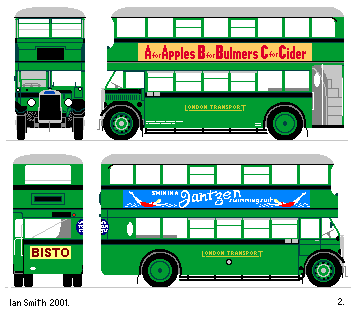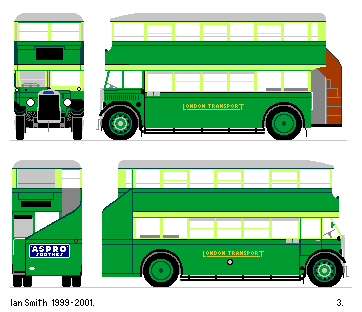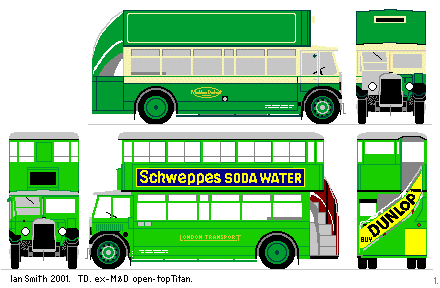
The LONDON TRANSPORT Leyland Titan TDsThis page created 18th July 2001, updated 17th December, using Notepad, by Ian Smith. Best on Netscape 800*600.
Part Two: the Green Titans The establishment of the boundary of the London Transport area cut right across several 'boundary' towns,
where some large operators suddenly found themselves banned from half the town,
while the new LPTB was banned from the other half.
The establishment of the boundary of the London Transport area cut right across several 'boundary' towns,
where some large operators suddenly found themselves banned from half the town,
while the new LPTB was banned from the other half.
Gravesend & Dartford: TD133-TD166In Gravesend it was Maidstone and District who lost a large proportion of their services to the new Board. Together with the transfer of services came a large number of buses, plus Northfleet and Dartford garages. The buses included 34 Leyland Titans: 2 lowbridge, 9 open-toppers and 23 highbridge buses.The highbridge and lowbridge buses were almost standard Leyland Titans, except that the Leyland pattern bodies had been built by Short Bros of Rochester. The high buses, TD133-142 and TD154-166, built in summer 1931, had enclosed rears, piano fronts, sharply raked windscreens, dual lifeguards and deep front valances. The bodies were very square, with upright front windows, with outward opening hoppers under the flat-cap front style of the roof. There was a slight inwards taper towards the front. Highbridge ex-Maidstone & District TD, body by Short Bros. The two lowbridge buses, TD152-153, had the Leyland patent offside sunken gangway
with four-seater bench seats on the top deck, with the amazing low height of 13 feet.
They appear to be almost identical with the all-Leyland lowbridge model.
The two lowbridge buses, TD152-153, had the Leyland patent offside sunken gangway
with four-seater bench seats on the top deck, with the amazing low height of 13 feet.
They appear to be almost identical with the all-Leyland lowbridge model.
When taken over, the buses were of course still in Maidstone and District livery of green and cream. They also had small Leyland-standard destination apertures on the front of the 'piano'. Country Area first applied its own legal lettering, of course, followed by General fleetnames over the M&D livery. In time they received two-tone green with black trim and silver roofs, plus a larger destination box, that on the front required a projection up from the piano front. M&D practice had been to paint rear number plates on the rear window, but LT replaced these by plates above the window beside the rear light. Likewise, LT may have replaced whatever blind arrangements M&D had on the back, but initially used the projecting single-line blind box. Lowbridge ex-Maidstone & District TD, body by Short Bros. The open-toppers taken over from Maidstone & District, TD143-151,
at first continued working where they were,
on Thameside duties.
At the very beginning all that showed that the LPTB had taken over was the legal lettering,
applied on both sides.
The open-toppers taken over from Maidstone & District, TD143-151,
at first continued working where they were,
on Thameside duties.
At the very beginning all that showed that the LPTB had taken over was the legal lettering,
applied on both sides.
But open-toppers were not in the Board's scheme of things, and once Chiswick took over maintenance and renewals in 1935 they were quickly fitted with NS-style covered tops, with sliding windows on the top-deck. They found a home at Slough, on the town/industrial estate duties (444, 445), going to Windsor for the same duties once Slough closed. Open-top ex-Maidstone & District TD, body by Short Bros. At first they were used in M&D livery. Later they were fitted with NS-style tops. Rear view speculative.The Chiltern Country Titans: TD167-173Aston's of Watford and Prentice & Sons (Tring) both brought Titans when they were taken over by London General Country Services in May 1933, which five buses passed to the LPTB on vesting day in July 1933. Aston had a pair of 1930 Dodson-bodied TD1s, TD170-171, with a body style not disimilar to the standard Leyland product, only with five bays rather than six.Prentice & Sons, trading as Chiltern, brought a more mixed bag: TD167 was a Leyland lowbridge TD1, bought secondhand from Burnley; TD172 was similar but bought new; while TD173 was a Leyland highbridge bus. They received treatment from London Transport similar to the Maidstone & District buses, which were almost identical. Thames Valley Thames Valley lost some of their Weybridge - Woking services in the trimming of the London boundary, and passed over two very useful lowbridge Leyland-bodied buses that would prove useful in the Staines area: TD168-169. The GreenLine Coach Titans Premier Line was one of Green Line's competitors, and ran successful express services
between London and Windsor and Farnham Royal.
It used a mixed fleet of Leyland Tigers and Titans,
taking advantage of the latter's long wheelbase
to mount coach bodies by Duple or London Lorries.
Premier Line was one of Green Line's competitors, and ran successful express services
between London and Windsor and Farnham Royal.
It used a mixed fleet of Leyland Tigers and Titans,
taking advantage of the latter's long wheelbase
to mount coach bodies by Duple or London Lorries.
The company, which was part of Premier Omnibus was taken over by the LPTB in December 1933, and brought eighteen of the coach Titans (TD174 - 191) as well as coach Tigers (TR class).
These were incorporated into the Green Line business,
and soon appeared with large Green Line labels over the Premier livery.
It took longer to change the illuminated Premier sign and service indicator on the roof,
but these were converted to show the ultimate destination while the old destination indicator
in the front of the roof was now used to show "Green Line".
Many continued to operate from the old Premier depot, now Slough (Bath Road) garage (SU),
until transferred to Windsor when SU closed in 1936.
The Redcar Titans: TD192-195London Transport had a protracted wrangle with Redcar Services of Tunbridge Wells over compensation, relating to its London - Sevenoaks - Tunbridge Wells service. The argument was not solved until Maidstone & District took over Redcar in 1935 and promptly let London Transport operate both the express service and the local Sevenoaks - Tonbridge bus service. The deal included the passing of four Titans - two with Weymann highbridge bodies and two Leyland-bodied - to LPTB.In addition to these "natural" Country buses there were the two single-deckers from Central Area Independents, TD86 and TD131, which were allocated to the Country Area. Service and withdrawalThe normal-height Country Titans found themselves concentrated initially at Dartford (DT) and Northfleet (NF) garages, where most of them had come from. Later many went to Slough (SL) for local services, and then to Windsor garage (WR) for the same duties when Slough closed. From 1934 some went to Grays (GY) where their extra size was needed compared with the small buses originally allocated there. They were reinforced by a trickle of Titans from the Central Area.The demise of the Titans was sealed when the Country Area received new STL16s in the early summer of 1939. They directly replaced the TDs and some front entrance STLs at NF and DT, the new buses' greater seating capacity proving useful on these heavily used services. The displaced Country STLs went to Windsor to oust the Titans there, while AEC Qs and STs from Hertford went to Grays to take over from their TDs. Again the war meant disposal was not an option, while their petrol engines inhibited re-use. Many went to Millburn's in Preston in 1940, and hence to munitions factory services for Liverpool Corporation. SurvivorsIt seems from the St.Helen's Museum of Transport fleet list that they have two survivors: ex M&D TD161 and ex Redcar TD193, both via Liverpool Corporation, and the latter as rebodied by Liverpool as a mobile canteen.
|
 Red TDs.
Red TDs. Part Two: Green TDs.
Part Two: Green TDs. TD histories
TD histories Ian's Bus Stop
Ian's Bus Stop